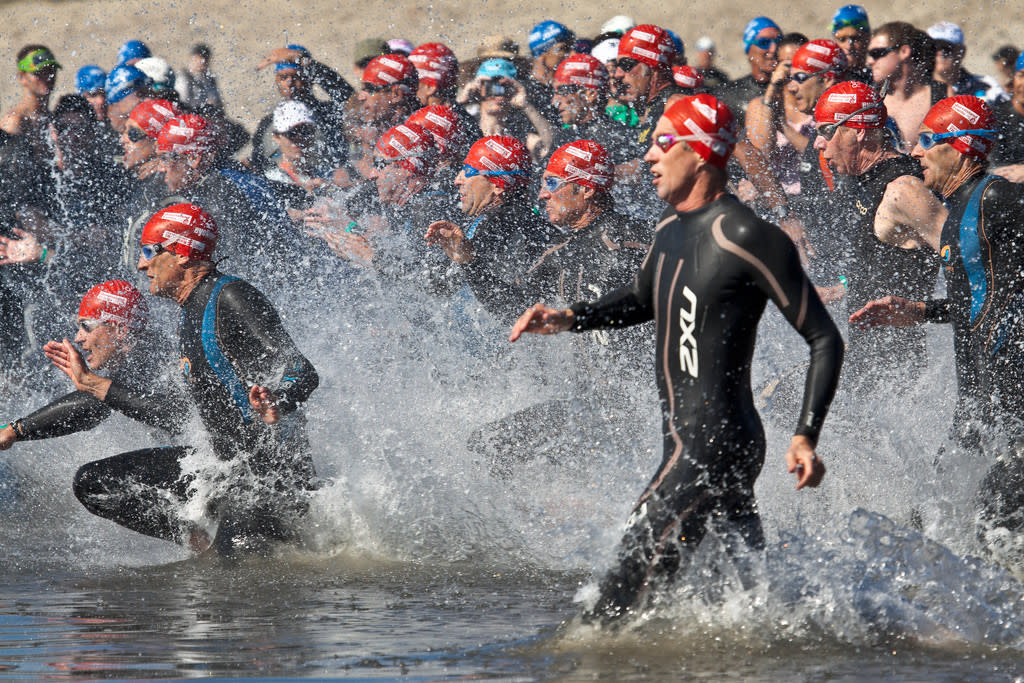Imagine adding a part-time job to your already crazy schedule. Turns out your friendly neighborhood triathlete has. Training for an Ironman—a 2.4-mile swim, 112-mile bike, and 26.2 mile run—requires a minimum of 20 hours per week for six months, the equivalent of adding a part-time job to the athlete’s schedule. Even a marathon with its relatively lower physical demands still necessitates four or five hour-long runs, speed training sessions, and at least one 10+ mile run weekly.
It’s easy to imagine athletes as the endurance equivalents of surf bums, people who work at a running store just often enough to pay for all of their race fees. After all, who could possibly train on top of a real job? But nearly half of athletes registered with USA Triathlon are white-collar workers, and 19 percent are doctors, lawyers, accountants, and other professionals. Ultramarathon and marathon runners also fit a similar demographic.
If you’re struggling to make time for spin class after work, it may seem impossible to reconcile a serious training schedule with an equally high-powered career. But not only do endurance athletes survive this insane schedule, they thrive on it, often registering for races the morning after their last one.
Whether you’re planning an Ironman or your company’s five-year strategy, you can apply some practices of endurance athletes to your own professional life. Here's how they do it:
They Use Exercise to Boost Their Brainpower

Exercise may grow your muscles, but it’s equally helpful for your mind. Any cardiovascular activity will increase the flow of oxygen and glucose to the brain, which helps synthesize ideas more quickly.
Muscle movements also send hormones rushing to your brain, including serotonin—a mood booster that also influences memory—and dopamine, which encourages us to work for rewards (i.e., a raise). Once they reach the brain, hormones mix with a protein called brain-derived neurotrophic factor which is involved in brain cell growth and learning.
Cardiovascular exercise also promotes neurogenesis, or the birth of new brain cells, enabling people to make novel connections between seemingly unrelated areas.
Translation: Exercise literally grows your brain. Researchers have even discovered that exercise training increased the volume of the hippocampus, the brain structure responsible for memory, by 2 percent. If that figure sounds insignificant, realize that a two percent growth of the hippocampus can offset one to two years of age-related memory loss. Better yet, because the hippocampal cells produced by exercise are newer and stronger than older ones, they’re more quickly integrated into our neural circuits and therefore more effective.
Several lines of research have linked these physical benefits directly to better work performance. People who exercise during their workday were 23 percent more productive on those days than they were when they didn't exercise, according to one study from the International Journal of Workplace Health Management.
Best of all, you can reap these benefits without biking 100 miles every Saturday. Even 150 minutes of moderate-intensity cardio per week can promote serious cognitive improvement.
They’re Driven by Purpose
Of course, none of those perks matter if you sleep through your swim session every morning. So how do serious athletes resist the snooze button? Although they truly enjoy physical activity, even the most dedicated endurance athletes are tempted by a warm bed and Netflix. To remain committed, they connect their training to a deeper purpose, from their communities to their personal fulfillment.
For some, it’s the memory of a loved one or a mantra. For others, it's their desire to test and transcend their mental and physical limits. For William Gane, who is planning to run 600 miles across California's Death Valley National Park this summer, it's raising funds for organizations that support gender equality.
When you feel particularly disengaged at your desk, reconnect to your own reasons for doing what you do. Are you inspired by your company’s mission? Do you feel invested in a creative process or your relationships with team members? Do you thrive on competition? Tapping into your "why" will get you back on track when you’re falling asleep during that conference call.
They Measure Their Results
Athletes can get obsessed with their stats, to the point that they’ll run laps around their house to turn a 4.9-mile run into an even 5-miler. To ensure that they train the right cardiovascular and respiratory systems, athletes need to enter each workout with a specific, quantified goal: Run 6 intervals at a given pace with 30 seconds of recovery or climb a hill with a 10 percent grade without slowing down. Such specificity leaves little room for excuses or ambiguity. These concrete goals also enable athletes to track their improvement over time, itself a powerful motivator.
So measure your own work product as concretely as possible. For recurring tasks, compare your performance with last week, last month, last year—and strive for improvement. Competition can easily inject excitement into an otherwise thankless task. Especially if you’re not emotionally invested in your job, compete with yourself to remain productive at work—and enjoy yourself in the process.
They Hold Themselves Accountable

Athletes also hold themselves accountable using coaches or, more recently, social media. Though a few athletes might use their Facebook posts to humblebrag, social media serves a powerful source of accountability for serious athletes, a way to congratulate, support, and even compete with one another. When he ran 3,067 miles from San Francisco to New York City last fall, Pete Kostelnick posted the entire journey on running and cycling app Strava for fans to follow. Just try skipping a day with the whole internet watching.
Though you likely won’t track your progress on your next work project through Twitter, you can set intermediate goals and deadlines for yourself. To increase team-wide accountability, consider setting up a communal calendar for team members to keep everyone apprised of their progress and to foster collaboration between employees.
They Don’t Manage Time—They Master Time
But as you’ve probably learned through painful experience, good intentions don’t compensate for poor planning. Since they have so little time to waste, endurance athletes plan every aspect of their day to death. They’ll pack their gym bag, lunch, and recovery tools the night—or maybe even a full week—before each workout. They’ll check the weather to protect against any surprises the following morning. They might even sleep in their running clothes to save a few sleepy seconds the next morning.
And after months of training, athletes don’t take chances on race day. They won’t sample a new breakfast food for fear of indigestion. They won’t wear the new shorts they found at packet pick-up the day before. Both during regular workouts and race days, athletes conserve all of their mental energy for the race at hand.
Their adherence to a strict schedule translates well to the workplace. After all, how many times have you stopped to check a few emails at 9 A.M., only to look up and realize that it’s time for lunch?
They Delegate and Prioritize
Unfortunately, nifty scheduling tools still can’t put us in two places in once. Nor can they insert extra hours into our days. Life happens: Sometimes there is literally not enough time to achieve every single thing.
It's easy to shut down from anxiety when staring at an overflowing to-do list. But when they're struggling to balance their hours-long workouts, professional obligations, family life, and relaxation, endurance athletes realize that doing something is preferable to doing nothing. Instead of scrambling to catch every ball they’re juggling, they decide which balls are worth dropping.
Meredith Atwood, an Ironman finisher, triathlon coach and blogger, provides triathletes a model for prioritizing with her Sucky Rotation Schedule. Essentially, athletes list all of their "sucky" responsibilities—their workouts, work projects, errands, chores, and whatever else—and split it with a Suck Line, which separates the "must-do" duties from the "nice to haves."
If they’re staring down a major deadline at work, maybe their swim workout falls below the Suck Line. Three weeks before race day? They’ll skip that stretch project for an extra bike session.
As your schedule fills with meetings and deadlines, create your own Sucky Rotation Schedule. A written list will help you visualize all of the responsibilities on your plate and decide which can be saved for tomorrow or next week. Can you delegate a few daily tasks to a junior employee? Can you save a side project or conference call until next week? Once you set your Suck Line, you can stick to it with confidence that you’re accomplishing as much as possible under the constraints of your schedule.
They Anticipate Deviations to the Plan

Even the best-laid plans can be derailed by last-minute emergencies. With time on their hands before a big race, endurance athletes will forecast any and all potential disasters. "What if my bike breaks down? What if the weather gets too hot? What if I crash halfway through the race?" With these nightmares scenarios in mind, they can prepare themselves for the unforeseen obstacles.
"If my bike breaks down, I’ll move off the road and find a race official for assistance. If I start overheating, I'll grab ice and slow down. If I lose my energy, I’ll ingest more carbs."
Triathlon coach Matt Fitzgerald suggests that our amount of suffering stems from expectations: We're less disappointed by setbacks when we're not shellshocked by them. Approach your high-stakes projects with a similarly cautious mindset. Once you’ve envisioned the worst-case scenarios and game-planned some alternatives, you’ll respond to unexpected setbacks more gracefully and rationally. While nobody is psychic, a proactive mindset makes it less likely that a shoddy Skype connection or unreliable partner will sink your success.
They Get to the Root of Their Underperformance
Have you ever put "spend three hours on social media" or "put off that performance review" on your to-do list? We never arrive at work excited to procrastinate the day away, nor do we strive to shoot ourselves in the foot. Yet we routinely undermine our own productivity by avoiding unpleasant tasks at work. Why, you ask?
When we ignore a specific work situation, we’re really resisting the underlying negative emotions that they produce. Not preparing for your big pitch to management? It could stem from your belief that you’re not worthy of success, anyway. Faking sick from another networking event? You could assume that you can’t spark interesting conversation, or that your skills and connections couldn’t possibly help anyone else.
But these self-defeating thoughts aren’t always based in reality, and Ironman and marathon finishers are as susceptible to them as us mere mortals. That's why when ultramarathon runner and adventure racer Travis Macy noticed that his own dysfunctional beliefs were undermining his training, he recognized them as fictional "stories" that can be rewritten.
In his book The Ultra Mindset, he counsels readers on how to rewrite their own stories to improve their performance, both in sports and in life.
- Step 1: Sit down and write the negative story. - Step 2: Read it and reread it. Recognize it for what it is: just a few words…nothing that should have the power to rule you. - Step 3: Write out positive alternative that can be used to battle it, and find a new ‘plot’ for your positive story. Could it be a new goal? Changing a behavior? Eliminating the negative? - Step 4: Turn one or more of these positive affirmations into a mantra. - Step 5: Determine what you will do to prove that the negative story is not true and that the positive story is true. - Step 6: Repeat the actions above, in any order, as many times as they need to be repeated.
Next time you’re saving your presentation to the last second or skipping a networking event, investigate whether your own negative stories are behind that behavior. Once you answer those questions, you can attack the underlying issues and stop self-sabotage in its tracks.
They Optimize Work Conditions to Maximize Efficiency

Endurance athletes are constantly seeking an edge. In their attempt to grow stronger, they become students of their sport, often taking up additional activities like strength training and yoga to reach new levels of fitness. As he increased his weekly mileage to 110 miles per week, ultramarathon runner Scott Jurek explored every possible avenue to become stronger. In his book Eat and Run, Jurek describes his own open-minded process of development.
"I was reading more about posture and stabilization and core strength. I hit the gym, working on my upper body, because I was beginning to realize how much a strong torso and arms could propel tired legs. I experimented with Pilates. I took up yoga for flexibility, body awareness, and centered focus. I even tinkered with my breathing."
Jurek’s experimentation has netted him enormous success: He’s won more than ten 100-plus mile races. So whether you’re an executive or an entry-level employee, seek unconventional ways to broaden your skillset. Learning how to use a new piece of software may not turn you into a Silicon Valley billionaire, but your knowledge could save you some time and headache in the future. Practical benefits aside, lifelong learning has also been found to reduce the risk of Alzheimer’s and depression among seniors.
They Prioritize Self-care
Have you ever hunched over your desk for so long that your back began to throb? Maybe you ordered some bad takeout during a long night? Or you pulled so many 12-hour days that you started snapping at everyone who looked at you the wrong way? You knew you should take better care of yourself, but you just couldn’t break your concentration or waste any time.
True, stretching, walking, and preparing meals can distract you from your tasks. But by skipping these vital self-care chores, you risk your long-term productivity, as these office-related health conditions are the leading causes of workplace disability.
Despite their hectic training schedules, endurance athletes devote time to recover properly afterwards. Take, for instance, elite marathoner Shalane Flanagan's extensive recovery routine. "I try to hydrate with an electrolyte drink and a snack that combines protein, fat, and carbs," she says, "I also use a foam roller to work out any tight areas that need help. For really deep tissue work, I see a physical therapist or massage therapist. If I am particularly sore or fatigued I will also take an ice bath or swim; I find the hydrotherapy to be helpful in flushing out toxins in the legs." So important is recovery that triathletes consider it the fourth discipline of their sport.
No matter how pressing your next deadline, incorporate the same self-care into your life, even (or especially) if it’s inconvenient. That extra yoga class may extend your project to tomorrow, but it will pay dividends in the form of increased concentration and mental clarity once you’re back at your desk. Similarly, the long-term benefits of a well-balanced diet and avoiding chronic health conditions far outweighs time and cost of cooking.
They Take Off-Seasons to Prevent Burnout
As unbreakable as they may appear, no athlete can maintain their peak fitness year-round. To prevent serious injury and mental burnout, endurance athletes plan substantial off-seasons following their last big race every year. Though she runs 90-100 miles per week leading up to her marathons, elite runner Tina Muir takes two full weeks off after each race. After winning the 2014 Boston Marathon, American marathoner Meb Keflezighi relaxed and proudly gained 12 pounds in the ten days following the race. This downtime allows both body and mind to rebuild themselves following the prolonged stress of a training season.
In today’s 24/7 work environment, professionals need to schedule their own off-seasons to avoid stress-related illness or burnout. If you work for the 4 percent of companies offering paid sabbaticals, take advantage of the opportunity to decompress on your company’s dime. If you lack this flexibility, consider planning one email-free day per week, as checking email consumes 28 percent of the workday and increases stress.
Whether you're training for an Ironman or gunning for a promotion, take some productivity tips from the endurance pros. Pace yourself. Get fit. Plan for the long term. Eke out every performance boost you can.
After all, your 40-year career is the ultimate endurance sport.
Continue Reading: Here's 16 ways to work smarter, not harder and get more done in the process.
Title photo by Presidio via Flickr; track photo by Pete via Flickr; bike photo by Priit Grepp via Flickr; solo bike photo by West Point via Flickr; wetsuit photo by Michael Dawes via Flickr.





